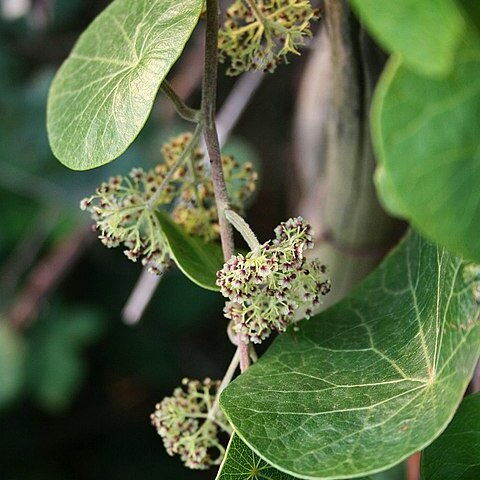A twining vine. It is woody at the base. It grows 20 m high. The small branches are hairy. The leaf blade is 5-20 cm long by 4-13 cm wide. They are broadly oval. There can be 2-4 flowers in the axils of leaves. The fruit is fleshy and 5-8 mm across. It is flattened. The stone has small prickles in 3 rows along it. The seeds are 8 mm long.
Leaf-lamina 5–20 x 4–13 cm., ovate to broadly ovate, rarely suborbicular, rounded at the base, obtuse or subacute at the apex, membranous or papery, slightly discolorous, glabrous or tomentellous, basal nerves 8–10, palmate, petiole 4–12 cm. long.
Male inflorescences of false compound umbels, axillary, solitary or clustered 2–4 together; axes glabrous or tomentellous; peduncle 4–10 cm. long with 3–6 rays ending in umbel-like cymes; involucre of 3–5 caducous bracts.
Male flowers with 6––8 obovate or subobovate sepals 1.2–2.5 x 0.6–1.2 mm., purplish, their bases often violet; petals 3–4, 0.8–1.2 mm. long, broadly ovate or suborbicular; synandrium 6–8-locular.
Drupe subspherical-flattened, 0.5–0.8 cm. in diam., glabrous; endocarp with small prickles or thick tubercles arranged in three lines; condyle not perforated.
Twining liane, woody at the base; stem covered with a thin bark; branchlets glabrous or more or less densely pubescent to tomentose when young.
Female flowers with 3–4 sepals; carpel glabrous.
Female inflorescences similar to the male.
Seeds up to 0–8 cm. long.

